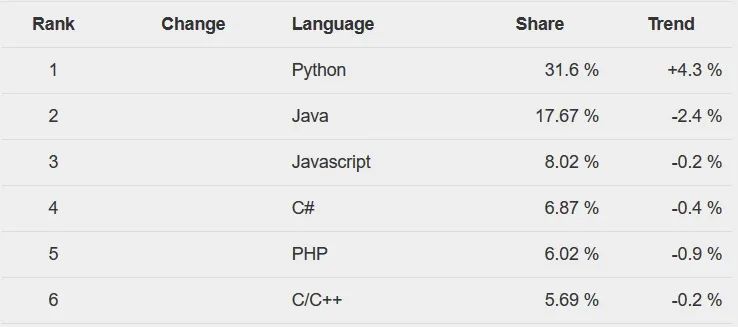
Python 最近在计算机科学领域占据主导地位,其应用领域包括机器学习、数据科学、人工智能、网络开发和软件编程,这些都是21世纪的最新趋势。 根据 PYPL 编程语言普及指数,与其他编程语言相比,python 大约占总份额的31.6% 。

所以,我想我们可以用最好的方式来学习 python,通过构建一个精彩的项目来掌握任何编程语言中的一个基本原理—— sorting。在本文结束时,你可以用五种不同的算法构建一个令人惊叹的排序可视化工具:
•选择排序•冒泡排序•插入排序•归并排序•快速排序
算法
让我们创建一个名为 algorithms.py 的文件,在这个文件中,我们将用 python 编写所有的排序算法。导入 time 模块来告诉用户可视化工具所花费的时间(注意: 显示的时间是系统渲染可视化工具所花费的时间,与排序算法无关)。创建一个称为 Algorithm 的类,并将这段代码粘贴到这里:
class Algorithm:
def __init__(self, name):
self.array = random.sample(range(512), 512) # Random array of size 512
self.name = name # Get name of the variable
def update_display(self, swap1=None, swap2=None):
import visualizer
visualizer.update(self, swap1, swap2) # pass the indexes to be swapped into the visualizer
def run(self): # Start the timer and run the algorithm
self.start_time = time.time()
self.algorithm()
time_elapsed = time.time() - self.start_time
return self.array, time_elapsed
我们最初将创建一个大小为512的随机数组。在 update_display 方法中,我们将调用 visualizer.py 中的 update 函数,稍后将编写这个函数来处理图形。最后,run 方法将启动计时器并调用算法函数,这是每个排序算法的一部分。它返回已排序的数组和运行时间。
选择排序
class SelectionSort(Algorithm): def __init__(self): super().__init__("SelectionSort") def algorithm(self): for i in range(len(self.array)): min_idx = i for j in range(i+1, len(self.array)): if self.array[j] < self.array[min_idx]: min_idx = j self.array[i], self.array[min_idx] = self.array[min_idx], self.array[i] self.update_display(self.array[i], self.array[min_idx])Selectionsort 类将继承 Algorithm 类,在其算法方法中我们实现了 Selection sort。每次数组更新时,我们不断调用 update_display 方法并实时呈现数组的排序。类似地,我们也实现了所有其他算法。

冒泡排序
class BubbleSort(Algorithm): def __init__(self): super().__init__("BubbleSort")def algorithm(self): for i in range(len(self.array)): for j in range(len(self.array)-1-i): if self.array[j] > self.array[j+1]: self.array[j], self.array[j+1] = self.array[j+1], self.array[j]self.update_display(self.array[j], self.array[j+1])插入排序
class InsertionSort(Algorithm): def __init__(self): super().__init__("InsertionSort") def algorithm(self): for i in range(len(self.array)): cursor = self.array[i] idx = i while idx > 0 and self.array[idx-1] > cursor: self.array[idx] = self.array[idx-1] idx -= 1 self.array[idx] = cursor self.update_display(self.array[idx], self.array[i])归并排序
class MergeSort(Algorithm): def __init__(self): super().__init__("MergeSort") def algorithm(self, array=[]): if array == []: array = self.array if len(array) < 2: return array mid = len(array) // 2 left = self.algorithm(array[:mid]) right = self.algorithm(array[mid:]) return self.merge(left, right) def merge(self, left, right): result = [] i, j = 0, 0 while i < len(left) and j < len(right): if left[i] < right[j]: result.append(left[i]) i += 1 else: result.append(right[j]) j += 1 self.update_display() result += left[i:] result += right[j:] self.array = result self.update_display() return result快速排序
class QuickSort(Algorithm): def __init__(self): super().__init__("QuickSort") def algorithm(self, array=[], start=0, end=0): if array == []: array = self.array end = len(array) - 1 if start < end: pivot = self.partition(array,start,end) self.algorithm(array,start,pivot-1) self.algorithm(array,pivot+1,end) def partition(self, array, start, end): x = array[end] i = start-1 for j in range(start, end+1, 1): if array[j] <= x: i += 1 if i < j: array[i], array[j] = array[j], array[i] self.update_display(array[i], array[j]) return i可视化工具
祝贺你!你只是写了所有流行的排序算法。最后一步是直观地显示每种排序算法的工作方式。
下面是 visualizer.py 文件的代码。
import algorithmsimport timeimport osimport sysimport pygame # Set the window length and breadth (Make sure that the breadth is equal to size of array. [512])dimensions = [1024, 512]# List all the algorithms available in the project in dictionary and call the necessary functions from algorithms.pyalgorithms = {"SelectionSort": algorithms.SelectionSort(), "BubbleSort": algorithms.BubbleSort(), "InsertionSort": algorithms.InsertionSort(), "MergeSort": algorithms.MergeSort(), "QuickSort": algorithms.QuickSort()}# Check list of all the available sorting techniques using 'list'if len(sys.argv) > 1: if sys.argv[1] == "list": for key in algorithms.keys(): print(key, end=" ") # Display the available algorithms print("") sys.exit(0)# Initalise the pygame librarypygame.init()# Set the dimensions of the window and display itdisplay = pygame.display.set_mode((dimensions[0], dimensions[1]))# Fill the window with purple huedisplay.fill(pygame.Color("#a48be0"))def check_events(): # Check if the pygame window was quit for event in pygame.event.get(): if event.type == pygame.QUIT: pygame.quit(); sys.exit();def update(algorithm, swap1=None, swap2=None, display=display): # The function responsible for drawing the sorted array on each iteration display.fill(pygame.Color("#a48be0")) pygame.display.set_caption("Sorting Visualizer Algorithm: {} Time: {:.3f} Status: Sorting...".format(algorithm.name, time.time() - algorithm.start_time)) # Display on title bar k = int(dimensions[0]/len(algorithm.array)) for i in range(len(algorithm.array)): colour = (80, 0, 255) if swap1 == algorithm.array[i]: colour = (0,255,0) elif swap2 == algorithm.array[i]: colour = (255,0,0) # The most important step that renders the rectangles to the screen that gets sorted. # pygame.draw.rect(dsiplay_window, color_of_rectangle, size_of_rectangle) pygame.draw.rect(display, colour, (i*k,dimensions[1],k,-algorithm.array[i])) check_events() pygame.display.update()def keep_open(algorithm, display, time): # Keep the window open until sort completion pygame.display.set_caption("Sorting Visualizer Algorithm: {} Time: {:.3f} Status: Done!".format(algorithm.name, time)) while True: check_events() pygame.display.update()def main(): if len(sys.argv) < 2: print("Please select a sorting algorithm.") else: try: algorithm = algorithms[sys.argv[1]] # Pass the algorithm selected try: time_elapsed = algorithm.run()[1] keep_open(algorithm, display, time_elapsed) pass except: pass except: print("Error.")if __name__ == "__main__": main()太好了!我知道,有很多代码需要消化,但我向您保证,当您按下这个项目的运行按钮时,它将会取得丰硕的成果。同时,让我向您解释一下可视化工具代码。
首先,我们导入我们编写算法的算法 python 文件。然后,在 python 中导入 pygame 模块来处理我们项目中的图形。
另外,通过在终端中执行 pip install pygame 来安装 pygame。
设置维数组中的窗口大小,并确保保留第二个参数512,因为这是我们正在使用的随机样本数。
接下来的几行命令将向用户显示可用算法列表,并提示他们选择一个并在运行代码时输入。
然后,初始化 pygame 模块,设置窗口的尺寸,并用颜色填充显示器。
检查事件函数用于在关闭窗口时退出程序。
其次是整个程序更新方法中最重要的功能。这个方法在每次迭代之后接受数组,并且手头有两个交换变量,swap1和 swap2变量。这些变量被赋予不同的颜色。
然后我们使用 pygame.draw.rect()函数将这些数组元素渲染到窗口并更新它。
只要 pygame 窗口仍在运行,而且窗口没有被终止,那么保持 open 函数就会保持 pygame 窗口处于打开状态。
最后,主函数将用户选择算法作为输入,并调用具体算法及其定时器。
结果
最终,是时候运行我们的项目了。在 project 目录中打开终端,执行 python visualizer.py 列表以获得所有可用算法的列表。


往期推荐
「测开」和「测试」的区别是什么?
微软官方再次上线了Python教程,这次比较高级
Windows Terminal 1.0 正式发布





















 258
258

 被折叠的 条评论
为什么被折叠?
被折叠的 条评论
为什么被折叠?








